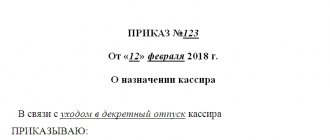Accounting Rules
The main one for an accountant is Federal Law No. 402-FZ dated November 6, 2011. It obliges all enterprises to ensure that accounting records are maintained according to established standards. The head of the company is responsible for its organization and the reliability of the data.
The Regulations on accounting at an enterprise (Order of the Ministry of Finance dated July 29, 1998 No. 34n) formulate the key rules that an accountant must adhere to:
The director of the company, in agreement with the chief accountant, approves the list of persons who have the right to sign on primary accounting documents.
All operations must be reflected in the programs at the time they are performed. As a last resort, immediately after the transaction.
The company’s internal document flow rules stipulate the frequency of formation, the procedure for signing primary documents, and the timing of their transfer within the organization. Authorized persons are responsible for the accuracy of the data in these documents.
Reporting must comply with legal requirements. Then the tax authorities will not have any questions. And for investors or creditors, accounting will become a reliable basis for making thoughtful management decisions.
Number of employees
If a business owner decides to create his own accounting service, then first of all the question arises about its number.
The staffing of the accounting department does not directly depend on either the total number of personnel or the company's turnover. Accounting is primarily the processing of documents, so its complexity follows from the number of “papers”.
Accounting document flow (organization and procedure)
But the same revenue can consist of either 2-3 shipping documents or several hundred. And if we take wages, for example, it is often easier to calculate them for 100-150 salaried office employees than for 20-30 workers at complex piece rates.
To assess labor intensity, you can take the standards approved by Resolution of the Ministry of Labor of the Russian Federation dated September 26, 1995 No. 56. They are recommended for budgetary organizations, but can also be used by commercial ones as a guideline.
Experts from the Ministry of Labor recommend using the following formula to estimate the required number of accounting departments: H = (T/1910) x Kn , where T is the total labor intensity of all functions performed by accountants per year;
Kn - absenteeism rate: Kn = 1+(Mon/(100) , where Mn is the expected percentage of absenteeism (vacations, sick leave, etc.). 1910 - the average number of working hours per year, which is recommended by the developers of the instructions. Labor intensity of all the main accounting functions are given in the tables (part 3 of the standards).
Example
Let us assume that the total planned labor intensity of all work performed by accountants for the year is equal to 4000 hours. Absenteeism rate is 1.15. H = (4000/1910) x 1.15 = 2.40 According to the rules of arithmetic, the estimated number of specialists must be rounded to 2. But other factors should be taken into account here. The mentioned resolution No. 56 was adopted in 1995. At that time, the level of automation of accounting processes was significantly lower than it is now.
Therefore, using the Ministry of Labor standards, you need to take into account the extent to which accounting automation has been implemented in your company. In many cases, this can significantly reduce the need for personnel.
More details
Accounting methods
Each fact of the enterprise’s economic activity is subject to systematization and analysis. Must be taken into account:
- debts;
- income;
- expenses;
- movement of goods;
- production costs.
All businesses must keep records of assets, debts and sources of financing. However, accounting for large corporations and firms with 5 employees will vary.
The accounting policy is formed by the enterprise independently and approved by order. In fact, this is a set of accounting methods that management chooses:
- asset inventory;
- write-off of depreciation of their cost;
- method and degree of grouping of costs;
- assessment of production processes;
- rules for applying the chart of accounts and maintaining registers and reporting.
On what basis does an organization choose one or another method of accounting? For example, accounting may not be kept:
- Individual entrepreneurs, organizations related to the Skolkovo Information Center, non-profit organizations and small businesses on the simplified tax system;
- Divisions of foreign companies working according to the laws of their country when organizing accounting.
Sometimes it is necessary to change or adjust the approved enterprise policy. For example, an LLC moves from the category of large enterprises to the category of small ones and chooses a simplified form as a method of accounting.
The role of an accountant in the work of an enterprise
The work of an enterprise is the constant making of certain decisions by management, thanks to which the company develops a further operating strategy. Every decision must be rationally weighed and based on the actual performance of the company. Each of these decisions is recorded in accounting, processed and influences further planning of work issues.
Accounting functions in a company:
- All financial transactions, without exception, must be recorded in accounting documents (registration).
- All data recorded in accounting documents is processed. With their help, you can display indicators of economic activity, the rational use of resources, both material and labor, and obtain an analysis of the work of individual departments and production units (information).
- Thanks to accounting, it is possible to determine the company’s compliance with standards and plans over a certain period of time. The rationalization of the use of resources in certain time periods can also be determined using accounting analytical data (feedback).
- Analyzing all the received data of the enterprise, the accounting department summarizes the information and calculates the main performance indicators of the enterprise. Only with the help of accounting can you increase net income and make timely decisions to avoid bankruptcy (analytical).
- During the production process, accounting carries out preliminary, final and current control over the company's activities. Control makes it possible to understand whether the company is achieving its goals and plans (control).
- The accounting department carries out inventory activities annually. An inventory of all property that is listed on the company’s balance sheet is carried out. Summarize lost assets and those that cannot be used (ensuring the safety of property).
Accounting carries out analytical, control, information and registration activities.
Forms of accounting at an enterprise
There are several forms of accounting. Each of them has its own characteristics and is suitable for a limited number of enterprises.
A simple form of accounting . Suitable for small businesses carrying out no more than 30 transactions monthly.
Form of accounting using accounting registers . A small business enterprise can use accounting sheets of forms No. B-1 - B-9.
Memorial order form of accounting. It is based on separate maintenance of systematic and chronological records. Synthetic accounting is kept in the general ledger, analytical accounting is kept in cards or books. It is possible to use memorial orders for small enterprises.
Journal-order form of accounting . Two registers are used - the order journal and the auxiliary (cumulative) statement.
Automated form of accounting . The basis is comprehensive automation (from primary documents to reporting).
It is very important to choose the right form of accounting for your enterprise. It will provide an optimal reflection of data and allow you to systematize it for the company’s internal purposes. When choosing, you need to consider:
- size and structure of the enterprise;
- used accounting registers and connections between them;
- automation of accounting processes;
- sequence of data entry.
Basic forms of accounting: features and differences
Let's consider the most popular of the listed forms of accounting:
Memorial warrant
The memorial order system is the optimal form of accounting for budgetary organizations, since it allows you to clearly and consistently reflect information on each account.
Record keeping is carried out through memorial orders drawn up on the basis of verified and grouped by specific characteristics of primary documents. All completed memorial orders for the current reporting period are entered in chronological order into the registration journal, after which information on them, specifically for each synthetic account, is reflected in the General Ledger.
Magazine-home
One of the most common and applicable in any industry and form of enterprise activity. Experts consider this form of accounting to be a simplified version of the memorial order system, which allows for convenient and detailed generation of information necessary for financial reporting.
Keeping records using this form involves entering information data from primary and consolidated accounting documents into journals and statements, which indicate the amounts reflecting the debit and credit turnover on the corresponding account. At the end of the current accounting period, the final entries for each account are transferred to the General Ledger, according to which the company’s balance sheet is formed.
Simplified
A simplified form of accounting is used for small enterprises that have a small number of business operations in the reporting period.
Two options for maintaining records in a simplified form are allowed - simple and using property registers.
In the first option, all business transactions are reflected exclusively in the Business Transactions Book without the use of double entry. In the second option, in addition to the Business Operations Accounting Book, the use of accounting registers - statements is additionally provided.
The main difference between the listed forms of accounting is the registers used. The choice of the optimal form remains with the enterprise, based on the specifics of its activities. Any of the used forms of accounting can be automated, which greatly simplifies the organization and maintenance of accounting for any modern enterprise.
Accounting software
Today there are many computer programs for accounting businesses. The following products are available to representatives of small businesses (IE, LLC):
| Name | Online address | A comment |
| My business | https://www.moedelo.org/ | For freelancers and small businesses |
| Elbe | https://kontur.ru/elba | For individual entrepreneurs and small LLCs on the simplified tax system, UTII and patent |
| Fingu.ru | https://fingu.ru/ | An outsourced accountant will be able to keep records, generate reports and submit them to the tax service |
| 1C: BusinessStart | https://1cbiz.ru/ | For beginning entrepreneurs |
| Infin. Online | https://www.infin.ru/ | Online accounting, as well as a system for managing purchases, sales and personnel |
The most popular programs based on 1C:
- 1c accounting
- 1C: BukhService.
Options for primary accounting organization
Since the responsibility for organizing accounting and the correctness of its maintenance lies with the manager, it is up to him to choose the form of implementation of the accounting service. There are various ways to solve this issue:
- Director and accountant rolled into one. This method is suitable for beginning businessmen who carry out a relatively small number of business transactions; it makes sense to use it on the simplified tax system and UTII. The law allows the manager to perform the duties of the chief accountant.
Pros:- gaining important experience;
mastering the nuances of accounting;
- saving on the salary of another full-time position or paying for outsourcer services.
Minuses:
- the inevitability of mistakes, especially at first;
- every mistake means a fine, and a tax violation also means freezing your current account;
- mastering accounting requires time that can be spent more productively.
IMPORTANT! If the company is developing progressively, there comes a time when this option ceases to justify itself, and it is necessary to make a decision to review it.
Pros:
- freeing up valuable time for the manager;
costs less than hiring a permanent accountant;
Minuses:
- slow pace of information exchange;
- additional costs for more complex wiring;
- additional payment for work at non-standard hours.
Cost of accounting services
CBS Group is among the Top 100 largest companies in Russia in auditing, consulting and outsourcing. It offers accounting services to small and medium-sized businesses. Cost of services:
| Types of services | Price, rub.) |
| Comprehensive accounting support | Prices depend on annual turnover: up to 15 million – from 14900 from 15 to 50 million – from 19990 from 50 to 100 million – 24900 from 100 to 200 million – 34900 over 200 million – from 44900 |
| Salary calculation | from 4900 |
| Outsourcing of HR records | from 4900 |
| Function of the chief accountant | from 9900 |
| Turnkey accounting | from 14900 |
| Restoration of accounting and taxes | from 34900 |
| Unlimited accounting | from 68900 |
You can calculate the cost of accounting services for a specific order using a calculator. You can submit an application or ask a question on the company’s website.
How to use the results of business process descriptions
Based on the flowcharts, a process tree and a responsibility matrix are compiled (Table 2). All business processes are entered vertically, and all participants in the processes horizontally. Letters are placed in empty cells, for example: O - responsible, owner of the process, U - participant, I - executor - responsible in the absence of the process owner.
After agreeing on the responsibility matrix, I begin writing job descriptions. Such instructions are very different from the standard ones, which are often downloaded from the Internet.
But I want to note the following: not all positions require such an approach and such content. In the job descriptions of managers at all levels, creative specialists, great emphasis is placed on the required results, and not on the method of obtaining them. Below are all sections of the job description with comments on the content of each section.
| Job description section | Comments for this section |
| 1. General Provisions | Appointment, dismissal, replacement, subordination |
| 2. Knowledge requirements | Detailed knowledge requirements, including software products, legislation on accounting areas, knowledge of the organization’s internal regulations |
| 3. Preparation for work | Opening an office, requirements for a workplace, launching programs, readiness for work at the start of the working day. |
| 4. Objectives of the position | As a rule, a list of processes is obtained in which the position is responsible. |
| 5. Business processes in which the accountant participates | Previously, I indicated only those processes in which a specific accountant is involved, now I present the entire responsibility matrix: it shows the amount of work of the entire accounting department and the processes that this accountant must also know in order to replace another accountant. All flowcharts are an appendix to the job description. |
| 6. Fulfillment of job duties and operations arising as they become available | All operations whose deadlines are tied to the moment of receipt (within 3 hours, during the working day) or there are no strict time constraints. |
| 7. Fulfillment of job duties and operations regulated during each working day | During each working day, the employee carries out operations, the execution time of which is strictly defined. For example, in order for the director to have a management report on his desk at 10 a.m., or to be able to generate it in the program, it is necessary for one accountant to carry out operations until 9:15, the other until 9:30. |
| 8. Performing job duties regulated by a specific date of the month | The employee carries out operations during each month, the date of which is strictly defined. The following operations must be completed on the specified date of the current month. |
| 9. Mandatory conditions | Confidentiality of information with which the accountant works, the time of mandatory presence at the workplace. |
| 10. Interaction with other employees | From whom, what information does it receive and to whom, in what form does it transmit. |
| 11. Submitted reporting | There is internal reporting, primarily managerial, which is not regulated by accounting. In addition, there is mandatory reporting to regulatory authorities. |
| 12. Registration of work results | Accountants accumulate a lot of primary documents, which it is advisable to distribute in the program daily, file them daily in folders for storage, and compile registers. If you don’t do this every day, then the work accumulates like a snowball, and it’s impossible to get it done. And the most unpleasant thing is if such work remains “inherited” to the newcomer after the employee’s dismissal. |
| 13. Criteria for assessing the activities of an accountant | Each position has its own criteria, but the most common ones are: ·
|
| 14. General responsibilities of an accountant | Responsibilities that all accounting employees perform: in the field of labor protection and fire safety, working with the company’s material assets, etc. |
| 15. Compliance with standards of behavior | For example, rules for conducting telephone conversations, both internal and external, are prescribed. After all, accounting for contractors is the face of the organization. Dress code, drinking and eating in the work area. |
| 16. Rights | What an employee has the right to do in relation to employees of other departments, for example: return incorrectly completed primary documents to the performers for revision, indicating errors; request from departments information and documents necessary to perform his official duties. |
| 17. Responsibility | There are 3 main points in standard job descriptions, which are formulated as follows: “the employee is responsible for non-compliance..., non-compliance..., offenses...,” as if if he complies with the requirements, but below a given level, he should not be held responsible. I propose a different approach: we prescribe what requirements the employee is responsible for fulfilling, with reference to individual points of the job description, primarily to tasks and criteria. |
| 18. Final provisions | Terms and rules for reviewing job descriptions, review procedure. |
Where to order accounting services
The best companies providing accounting services:
- CBS Group. Address: Moscow, st. Kalanchevskaya, 20/7. Phone, +7 (977) 893-37-69. E-mail: [email protected] Website – https://cbscg.ru.
- AccountProfi-Audit . Address: Moscow, Sredny Tishinsky lane, 8. Phone: +7 (495) 374-50-93. E-mail Website – https://accountprofi.ru/.
- SKB Kontur . Address: Moscow, st. Sushchevsky Val, 18 (10th floor). Phone: +7 (495) 212-21-15. E-mail Website – https://kontur.ru/.
- Accounting Service Center (ACS). Address: Moscow, Volgogradsky Prospekt, 35. Telephone. E-mail Website – https://bisbuh.ru/.
- Audit Capital . Address: Moscow st. Cosmonaut Volkov. 10, office 213. Telephone: 8 (499) 271-75-67. E-mail Website – https://audit-capital.tk/.
- RosCo . Address: Moscow, 1st Volkonsky Lane, 13, building 2. Phone: +7 (499) 444-00-00,. E-mail Website – https://rosco.su/.
- LINKAY. Address: Moscow, st. Kotsyubinskogo, 4. Telephone. E-mail Website – https://www.audit-linkey.ru/.
- BC "Active ". Address: Moscow, st. Bolshaya Novodmitrovskaya, 23/6, office 14. Phone: 8 (800) 700-58-71. E-mail Website – https://buhactiv.ru/.
- TAKE THAT . Address: Moscow Otkrytoye shosse, 9, building 14. Telephone. E-mail: [email protected] Website – https://www.naka.ru/.
- BUHprofi . Address: Moscow, 1st Volokolamsky Prospect, 10. Telephone, 8. E-mail Website – https://www.buxprofi.ru/.
The role of the manager in the organization of accounting
When hiring an accountant or outsourcing this activity, a manager cannot simply forget about such an important component of his business. He must ensure that, as a result, he receives in a timely manner complete and reliable information about all financial transactions of the company, its property, assets, human resources and controls their dynamics. To do this he needs:
- adopt the Regulations on the accounting service in your organization;
- draw up and approve job descriptions for accounting employees;
- take care of primary document flow;
- decide on what technology the credentials will be processed (as a rule, specialized computer programs are used);
- resolve documentation storage issues;
- Periodically check the shelf life of papers and clarify their value.
Where to take accounting courses
Many companies and educational institutions conduct training courses in the following areas: accounting, working in 1C, taxation. You can learn a profession from scratch or improve your qualifications. Accounting for an enterprise can be mastered in the following courses:
- Moscow Business School. Address: Moscow, Leninsky Prospekt, 38A. Telephone,. E-mail: [email protected] Website – https://mbschool.ru/.
- Medical expert. Address: Syktyvkar, st. Pervomaiskaya, 70, building A, office 407, 414. Telephone. E-mail: [email protected] Website – https://dist-ed.ru/.
- ANO DPO MASPC. Address: Moscow, Lubyansky proezd, 15, p. 2. Phone: 8 (499) 116-69-84. E-mail: [email protected] Website – https://maspk.ru/.
- VGAPS. Address: Volgograd, st. Kanunnikova, 6. Telephone. E-mail: [email protected] Website – https://vgaps.ru/.
- TC "Education and Career". Address: Moscow, st. Zemlyanoy Val, 7. Phone: +7,. E-mail Website – https://www.kursmsk.ru/.
Benefits of optimization processes
The advantage of automated calculations and reporting is the elimination of errors from calculations; formulas are clearly included in the programs, which are then used to generate reports. The only thing that is needed from an accountant is to enter all the initial data correctly and correctly.
Optimization and automation of the accounting process reduces labor costs, since the use of high-quality programs helps several employees cope with a large volume of work.
By the way: managers, shareholders, partners can request data on the company’s financial activities and receive them in a very short time; financial statements are not considered confidential documents and are provided upon request.
Optimization and automation of accounting is currently considered the main task in large enterprises that have subordinate branches.
It is through timely submission of data on the company's financial performance that the manager can make rational decisions that will help reduce production costs and increase the company's sales, which will increase the company's rating in the competitive market and generate more profits for the organization.
Common accounting mistakes
The most common mistakes when doing accounting:
- Primary documents. Lack of reports, their careless execution and low quality.
- Personnel accounting. You should not limit yourself to just an employment contract. All orders, instructions and certificates must be drawn up for each employee.
- Mathematical errors. From simple typos to incorrect rounding.
- Errors in the annual balance sheet. Arithmetic errors, incoming data in the annual balance sheet diverges from the outgoing data for the previous year, incorrect reflection of information on accounting items.
- Ignorance of legislation. The accountant cannot keep up with the chaotically changing rules of accounting and tax accounting.
Digital library
Finance and credit / Accounting / 3.2 Organizational structure of accounting, distribution of responsibilities in accounting
Organization of accounting involves
:
· development of organizational and administrative documents (regulations on accounting, job descriptions of accounting employees, staffing schedule);
· drawing up a document flow schedule for the organization;
· creation of a list of cases and organization of document storage;
· development of the accounting personnel policy (the procedure for certification of accountants, the system of personnel selection and advanced training);
· creation of technology for processing the received information (the applied form of accounting process).
In accordance with the Law “On Accounting” and the Regulations on Accounting and Financial Reporting in the Russian Federation, the head of the organization bears responsibility for organizing accounting and compliance with the law when carrying out business activities.
Depending on the volume of work, the heads of the organization can:
a) establish an accounting service as a structural unit headed by a chief accountant;
b) add an accountant position to the staff;
c) transfer on a contractual basis the maintenance of accounting to a centralized organization or a specialist accountant;
d) keep accounting records personally.
As already mentioned, the fundamental features characterizing the status of the chief accountant of an organization are defined in Article 7 of the federal law “On Accounting”. The chief accountant is appointed and dismissed by the head of the organization.
According to Russian legislation, the chief accountant:
1) is responsible for the formation of accounting policies, maintenance of accounting records, timely submission of reliable financial statements;
2) ensures control over the movement of property and the fulfillment of the organization’s obligations, compliance with the legislation of the facts of economic activity;
3) gives all employees of the organization mandatory instructions on documenting the facts of economic activity and submitting the necessary documents, reports, and other information for accounting.
A more complete list of job responsibilities of the chief accountant is presented in the appendix to the resolution of the Ministry of Labor of Russia No. 75.
For failure to fulfill or dishonest performance of his duties, the chief accountant is liable in accordance with current legislation.
When taking office, the chief accountant must first familiarize himself with the accounting regulations
, and in its absence, create this document and approve it with the head of the organization. It should reflect the goals, objectives and functions of the accounting department, relationships with other structural divisions of the organization, as well as the organization of the accounting process.
Job Descriptions
are drawn up for each accounting employee in order to delineate their powers, determine rights and responsibilities. Assigning accounting areas to an employee allows you to avoid duplication or concealment of individual facts of economic activity.
The main job responsibilities, requirements for knowledge and qualifications of workers must comply with the tariff and qualification characteristics provided for by Resolution of the Ministry of Labor of Russia No. 32 of June 6, 1996.
The job description specifies a list of documents received by the employee for processing, further transfer, and the availability of signature rights. The structure of the instructions corresponds to the accounting regulations and reflects the following sections:
1. General Provisions";
2) “Functions of an employee”;
3) “Rights and obligations”;
4) “Interactions with other employees of the accounting department and the organization”;
5) “Organization of work”;
6) “Rules for evaluating performance results.”
Job descriptions are drawn up by the chief accountant and approved by the head of the organization. After reading the instructions, the employee puts an o, date and signature. It is recommended that the text of the instructions be given to the accountant, which is also recorded with the inscription “instructions received in hand”, then a date and signature are added.
The hired chief accountant has the right to change job descriptions in accordance with his requirements. After this, they are approved by the head of the organization and brought to the attention of accounting employees.
In the staffing table
The following must be indicated: the total number of accounting employees, the names of positions, the main responsibilities of employees, the remuneration system and the amount of wages. Subsequently, certification of accounting department employees is carried out, based on the results of which the employee may be fired, transferred to another position, etc.
The chief accountant must reasonably determine the number of accounting employees and the degree of their qualifications. The required number of accountants is determined depending on the volume of information processed for each accounting object. Calculations for the number of accountants can be made based on standard time and service standards for accounting work. In accordance with the estimated number of accounting employees, its organizational structure is formed.
Accounting structure
depends on the conditions of the organization and production technology, the volume of accounting work and the availability of technical accounting tools. Currently, there are three main types of organization of the accounting structure:
· linear (hierarchical);
· vertical (line-staff);
· combined (functional).
With a linear structure
of the accounting organization, all its employees report directly to the chief accountant. This accounting structure is typical for small organizations with 7–10 people.
When organizing accounting vertically
Intermediate management units are created (departments, sectors, bureaus, groups), headed by senior accountants. In this case, the orders of the chief accountant are transmitted to senior accountants of the relevant departments, who identify specific performers and control the execution of work. The vertical structure of the accounting service is used in most medium-sized and some large organizations.
When using a combined type
organization of the accounting structure, it identifies structural divisions (for example, by production) that perform a closed cycle of work. The rights of the chief accountant in this case are transferred to the heads of the accounting departments, who independently manage within the established competence. This form of organization of the accounting apparatus is typical for particularly large organizations.
If there are more than two accountants, the accounting service must be formalized as a structural unit of the organization, headed by the chief accountant, who manages the accounting department. In accordance with the allocated structural divisions, the main functions and job responsibilities of the accounting service employees are distributed (Table 3.1).
Most accounting systems in world practice are characterized by the presence of two accounting departments: financial (general) and management (analytical, industrial).
Financial accounting
problems of the organization’s relationship with the state, banks, shareholders, suppliers, customers and other counterparties are resolved. The organization of financial accounting, corresponding to the national accounting system, is to one degree or another regulated by the state, and in many cases by a group of states represented by intergovernmental organizations. Financial accounting workers are engaged in determining the financial and property position of the company, assessing the assets and liabilities of the balance sheet, the amount of profit, and the directions of its use. Financial accounting provides information for publication in the public press.
Table 3.1 Functions and job responsibilities of accounting employees
| Structural subdivision (job title) | Functions, job responsibilities |
| Main accountant | 1. Preparation of accounting and tax statements of the organization 2. Control: — compliance with the established rules for processing the acceptance and release of inventories; — accuracy of payroll calculations; — correct application of tariff tables, official salaries, compliance with staffing, financial, class discipline; — collection of accounts receivable and repayment of accounts payable on time; — legality of writing off various losses and shortages; — the correctness of determining the profit subject to taxation and remaining at the disposal of shareholders; — over the calculation of taxes and fees paid by the organization, and the reliability of their transfer; — rational use of all types of organization resources, etc. |
| Deputy Chief Accountant for Accounting Issues | 1. Formation of income and expenses from ordinary, operating, non-operating and emergency activities, including calculation of the full cost of goods sold, products, work performed, services rendered. 2. Formation of the financial result of the organization |
| Deputy Chief Accountant for Tax Accounting | 1. Formation of income and expenses from sales and non-sales activities, and, consequently, profits subject to taxation, in consolidated tax accounting registers 2. Calculation of taxes payable to the budget: enterprise property tax, transport tax, value added tax 3. Other issues related to taxation |
| Labor and Payroll Accounting Department | 1. Calculation of wages, benefits, unified social tax, insurance and savings payments to the Pension Fund of the Russian Federation, collection from industrial accidents 2. Maintaining personal accounts of employees, cards, register and individual information cards, accrued amounts of the unified social tax and mandatory pension payments 3. Accounting for settlements on claims with employees (alimony, fines) 4. Formation of reporting in accordance with the working chart of accounts, as well as reporting on the listed taxes and fees 5. Maintaining relevant tax registers |
| Department for recording facts of economic activity at the cash desk | 1. Reception and issuance of cash and monetary documents 2. Maintaining a journal for registering incoming and outgoing cash orders 3. Maintaining a cash book and preparing cashier reports 4. Accounting for settlements with accountable persons and deposited amounts 5. Formation of summary entries on your site for the month and maintaining the corresponding tax accounting registers |
Continuation of Table 3.1
| Structural subdivision (job title) | Functions, job responsibilities |
| Department for accounting of banking facts of economic activity | 1. Preparation of payment documents for the transfer of various amounts of accounts payable 2. Working with the “Client-Bank” system 3. Registration of payment documents in the payment document registration journal 4. Monitoring the correctness of debiting and crediting funds to current and other bank accounts 5. Formation of summary transactions on your site for the month in accordance with the working chart of accounts 6. Maintaining relevant tax registers |
| Department for accounting of current settlements and obligations | 1. Accounting for settlements with the organization’s counterparties 2. Issuing outgoing invoices and recording incoming invoices in the registration journals 3. Formation of a purchase book and a sales book, as well as corresponding monthly transactions in accordance with the working chart of accounts 4. Maintaining relevant tax registers |
| Internal Accounting Department | 1. Reflection in the accounting of receipts of movement, use and disposal of material assets and non-current assets for accounting and taxation purposes 2. Formation of summary transactions on your site for the month in accordance with the working chart of accounts 3. Maintaining relevant tax registers |
Management
(
analytical, industrial
)
accounting
is aimed at solving internal problems associated with increasing operational efficiency in the context of responsibility centers and activity segments. Management accounting organizes synthetic and analytical accounting of the movement of material assets, finished products, and settlements with workers and employees. The activities of management accounting are not regulated by the state. Its main purpose is to present information and analyze it by responsibility centers, the profitability of business segments, and ensure accounting of income and expenses.
In different accounting systems, the relationship between financial and management accounting is carried out using a special system of accounts: reflective, intertwined, collective and distributive. In Russian accounting practice, systems of reflective accounts are used (30 – 39).
The interaction of the accounting department with other structural divisions of the organization is determined by the movement of documents in accordance with the approved document flow schedule. There are two options for organizing the accounting process:
1) centralized;
2) decentralized.
With centralization
The accounting process apparatus of the accounting service is concentrated in the main accounting department, where synthetic and analytical accounting is carried out on the basis of primary and consolidated documents coming from individual divisions of the organization. In the divisions themselves, only the primary registration of facts of economic activity is carried out.
In cases of decentralization
accounting process, the accounting service personnel are dispersed among individual production units of the organization, where
Analytical and synthetic accounting is carried out, separate balance sheets and reports are compiled for workshops, branches, and structural divisions. In this case, the main accounting department produces a summary of the balance sheets of the divisions, consolidates the balance sheet and reporting of the organization, and controls the organization of accounting in individual divisions of the organization.
The structure of the organization can include branches, separate divisions, and representative offices. In accordance with clause 8 of the Accounting Regulations “Accounting Statements of an Organization” (PBU 4), the accounting statements of an organization must include performance indicators of all branches and other divisions, including divisions allocated to a separate balance sheet.
Divisions can be allocated either to a separate balance sheet or remain part of the parent organization. The following schemes for organizing accounting in structural divisions are possible:
· Scheme 1 – the structural unit is not allocated to a separate balance sheet, the accounting process is carried out by the brand organization;
· Scheme 2 – a structural unit is allocated to a separate balance sheet, but does not have settlement (current) accounts;
· Scheme 3 - a structural unit is allocated to a separate balance sheet, has a current account, but does not independently sell goods, products, works, services (essentially it is a costly unit - a representative office of the parent organization in the region);
· Scheme 4 – a structural unit is allocated to a separate balance sheet, has current accounts, and independently sells goods, products, works, and services.
Responsibility for incorrect accounting
Administrative liability is provided for violations in accounting:
Distortion of accounting documentation may entail not only administrative, but also criminal liability. For example, for falsifying financial documents you can be imprisoned for up to 4 years (Article 172.1 of the Criminal Code of the Russian Federation).
Author of the publication
offline 21 Min
Where can I use this job description?
I saw at least 6 areas of use of the job description.
- When recruiting personnel.
- Upon induction.
- When assessing the importance of a position (determining official salaries)
- When assessing work results.
- When implementing changed processes.
- With automation.
Now I will describe it in more detail.
When recruiting personnel
During the interview, the candidate is given the opportunity to familiarize himself with the job description. It happens that the candidate apologizes immediately after reading it and leaves. It happens when a candidate says: “Standard job description.” But I saw a little different or this is the first job description that is given to read.
Such a job description makes it possible to more realistically assess the candidate’s competencies if you ask about individual sections: “What of the described things can you do, how did you do it, what suggestions and changes did you make, etc.” And the main thing is whether the candidate is ready to work in such a “transparency” mode.
Upon induction
For a beginner, you can draw up a plan for mastering the job description, what he should do and by when at a given level. Both the manager and the subordinate have the opportunity to assess the likelihood of successfully completing the probationary period, taking a snapshot of the implementation of the agreed plan, and not guessing: “Will they take it or not?”
When assessing the importance of a position (determining official salaries)
When assessing the importance of a position, job descriptions can be used to determine employee salaries. All the factors proposed by Edward Hay: the necessary knowledge and experience, solving problems (problems), the level of responsibility, are spelled out in detail in job descriptions.
As a result, it becomes possible to link official salaries to these factors and then rank them. Thus, official salaries are differentiated. It happens that employees themselves offer to redistribute functions in order to receive a higher salary, refuse simple operations and ask to be given more complex ones.
When evaluating performance results
The job description specifies the criteria by which the accountant’s activities are assessed. The chief accountant has the opportunity to talk constructively with subordinates, and not say: “I am not satisfied with the way you work.”
I have not yet come across a remuneration system for accounting employees that would allow us to evaluate the contribution of each employee to the results of the accounting department. I tried to do this.
The remuneration system may be based on job descriptions. For example, in one of the companies, together with the chief accountant, we found a solution that was enshrined in the “Regulations on the remuneration system for employees of the financial and accounting department.” The department has a fixed wage fund, which consists of the sum of salaries (fixed) and variable parts. Salaries were determined using the Hay method. We subtract the sum of all salaries from the wage fund, we get a variable fund. The ratio of constant and variable parts is approximately 70% and 30%.
Look at the same topic: How to properly pay an employee (Opens in a new tab)
How to distribute the variable fund among employees? For this, additional evaluation criteria are introduced, 3 in total, one of them is “completeness of fulfillment of the job description.” And one more criterion that works to reduce the premium is errors and violations.
The chief accountant regularly evaluates employees and informs them of the results. If you have the maximum score for three criteria, you can get 20 points, and violations and errors are scored from 0.5 to 1.5 points, depending on the severity. All these violations are specified and assessed in the Regulations.
The variable fund is divided by the sum of all accrued points, resulting in the cost of one point. And multiplying the cost of one point by the number of points received by the employee is the variable part of the employee’s salary. In general, the salaries of employees in a department may differ by 30-40%. In addition, by decision of the director, employees may be paid a bonus for outstanding results (in addition to the fixed salary fund).
Naturally, within the framework of this article I did not talk about all the intricacies and nuances of the remuneration system.
When implementing changed processes
Since we include changed processes in job descriptions, it is necessary to change the activity itself. To achieve this, the entire job description is reviewed in detail with each employee. It is advisable to certify employees on their knowledge of the changed processes.
When automating
During the description process, repetitive operations that take a lot of time are recorded - these are the primary tasks for automating such business processes. At this stage, I invite specialists who know accounting and management accounting, are able to see problems and formulate technical specifications for programmers. Unfortunately, I don't know how to do this.
Despite the fact that the work described is very labor-intensive: 15-30 interviews, 40-60 flowcharts, job descriptions on 15-20 pages, regulations on the remuneration system 10-12 pages, the result is worth it.
Such regulation allows you to receive, for example:
- consolidated forecast balance of a group of 8 companies at the beginning of the month, and not at the end, after submitting all reports;
- management reports for the past day on cash flow, income and expenses, product balances at different stages of the production process daily at 10 am;
- increasing the company's revenue by 2 times with a similar increase in document flow without increasing the number of accounting employees;
- expanding the functionality of the accounting department (budgeting, financial and economic analysis) without increasing the number of accounting employees;










